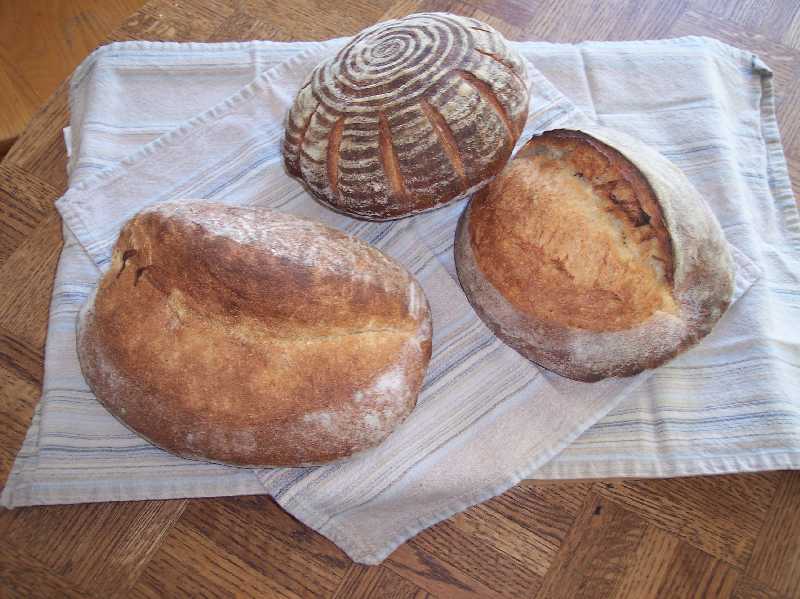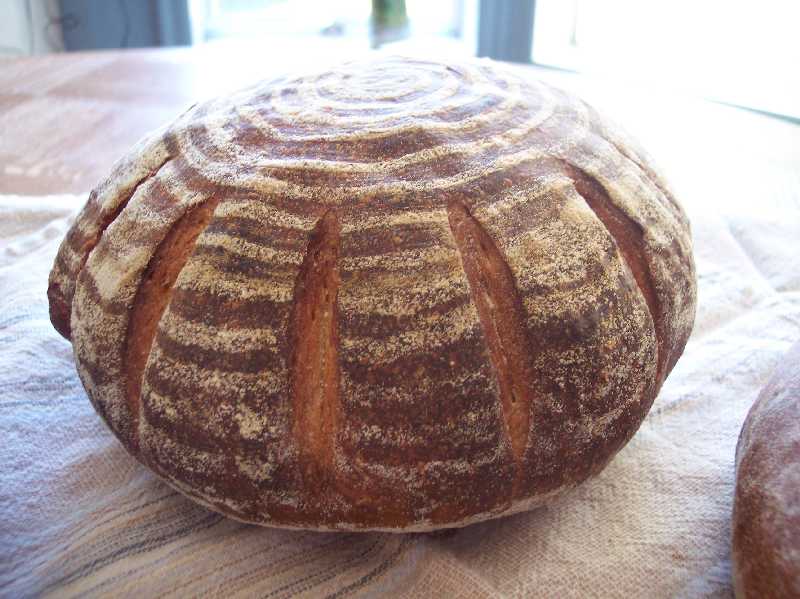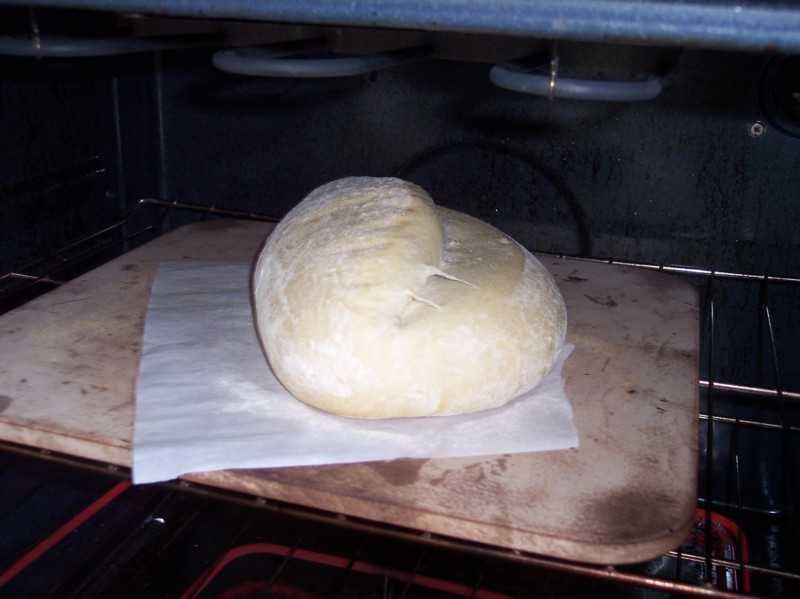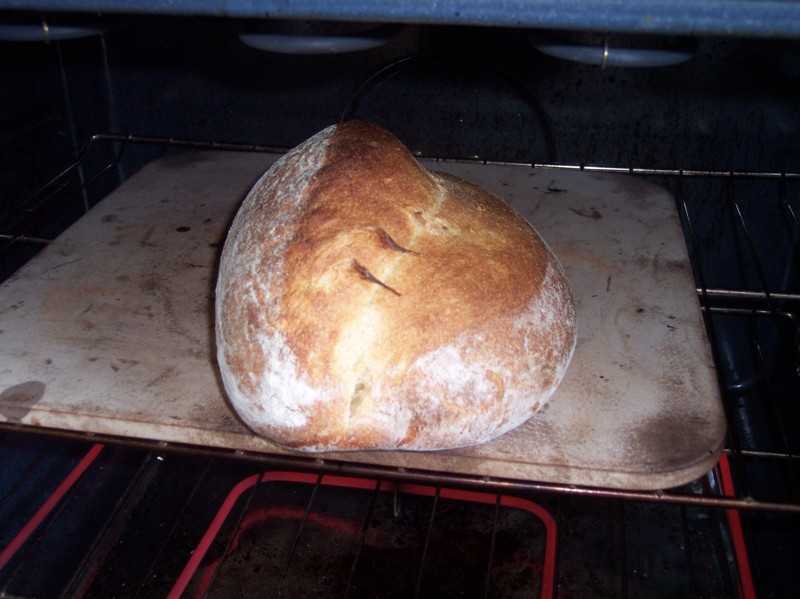
Pain au Levain with Red Fife 75% Sifted
Last week I posted a bake of this bread, http://www.thefreshloaf.com/node/24636/sweet-amp-sour that although a good loaf, I wasn't entirely happy with it because of it's close crumb and slight under baking. The finished loaf however resulted in a flavourful combination of the three different flours used in the mix, which I felt had good potential for an even greater flavour profile. One of the things I wanted to change from the last bake was the level of sour flavour, which was not as strong as I like. Since then I've been building my starter to a fairly stiff consistency to bring more acidity to it. With the warm temperatures we've been having here on Vancouver Island recently it's become a very active and tangy community of yeast cells. The mix, bulk ferment and final rise for Pain au Levain went well, giving me enough dough for two 800 gram loaves, one of which was shaped as a boule and placed in a brotform, and the other as a batard of sorts. I'd lined a wicker bread basket with linen and very clumsily sewn it into the basket to make a brotform, all the while suffering through stabbing myself repeatedly with the needle and hearing the occasional burst of laughter from across the room. It's not a thing of beauty but it does the trick, giving the dough a shape that's somewhere between a boule and a batard, or as David Snyder called a similar one of his, a 'boutard'. Both loaves went into a 500F oven turned down to 460F after 5 minutes and baked for 35-40 minutes with steam system in place during the first 5 minutes. With this bake I didn't have to rush off to a golf game, so the breads had a thorough bake, checking the internal temps for a 210F reading before I removed them to cooling racks and wrapped in linen. The loaves have a more pronounced flavour this time and a good sour tang that stays on the palate after eating. The crumb is more open than the previous loaf and with a bit of gelatinization as well. A good result for both loaves that I'm satisfied with.



Attamura Loaf
Somewhere along the way during the 3 builds of the levain I over- scaled and wound up with more levain than I needed for the Pain au Levain mix I was doing. Hmmm... Well rather than return the excess to the starter, I decided to try making an Altamura type bread using Atta flour, or Attamura, a project that Varda http://www.thefreshloaf.com/user/vhaimo has been working on over the last few weeks with some good results to show for her efforts.
The mix was made almost entirely with Golden Temple durum Atta flour except for the standard wheat flours and rye in the levain, roughly 67 grams total or 13.4% The levain was 27% of the mix, hydration was 70% (not counting the levain) and the salt at 2% for 500 grams of Atta flour. I did the mix using my new toy, a Bosh Compact, as it has a very gentle folding action when used on 1st speed that I felt would be just right for slowly developing the fragile gluten of the durum flour. The dough came together almost identically to ones that I've made previously using Extra Fancy finely milled durum flour, making a very smooth and supple dough. The dough had a temperature of 79.3F going into a 2 hour bulk fermentation and stayed in the mid 70'sF range throughout. Stretch and folds were done every 30 minutes and it was clear that the dough was gaining strength and fermenting well at each of these intervals. After the last S&F the dough was rested for 20 minutes and then shaped in a cap style by pressing the dough into a disk and folding it to almost meet the opposing side of the disk. The shaped loaf was placed fold down on floured linen and covered with another piece of floured linen for a final rise of 2 hours, then tipped on to a parchment covered peel and slid into a 450F oven on a stone.

So far so good, this might actually work I thought. The door of the oven was left open for the 1st 15 minutes, then closed for the duration of a 40 minute bake. No steam was used during the bake. After checking the loaf for an internal temperature of 210F, I left the loaf on the stone, turned the oven off and propped the door ajar to allow the loaf to cool gradually over the next hour.

The final result of this bake is something that looks like an Altamura type bread but has a deeper flavour than the one I made with Extra fancy durum flour a few weeks back. I actually prefer the flavour of the durum Atta flour over the X Fancy, which works out well as it's considerably less expensive and readily available here in B.C. I think two of the key factors in the success of this loaf was the high level of acidity contributed by the levain, as well as steady temperature during the bulk fermentation phase. Both Hamelman and Suas mention in their books 'Bread' and 'Advanced Bread & Pastry' respectively, that increased acidity and use of preferments will help strengthen the fragile gluten network of high ratio durum mixes. I'm satisfied now that a reasonably good loaf can be made using 100% (or very close to) Atta flour keeping these two factors in mind as critical to success.
Formulas and photos below.
Best wishes,
Franko
Pain au Levain with Red Fife 75% sifted |
|
| |||||||||||||||||||||||||||||||||||||||||||||||||||
Ingredients | % | Kg | |||||||||||||||||||||||||||||||||||||||||||||||||||
|
|
| |||||||||||||||||||||||||||||||||||||||||||||||||||
Levain |
|
| |||||||||||||||||||||||||||||||||||||||||||||||||||
Central Milling Artisan White Malted | 94 | 100 | |||||||||||||||||||||||||||||||||||||||||||||||||||
Nunweiler Dark Rye Flour | 6 | 6 | |||||||||||||||||||||||||||||||||||||||||||||||||||
Mature Starter-stiff | 20 | 21 | |||||||||||||||||||||||||||||||||||||||||||||||||||
Water | 60 | 64 | |||||||||||||||||||||||||||||||||||||||||||||||||||
|
| 191 | |||||||||||||||||||||||||||||||||||||||||||||||||||
Final Dough |
|
| |||||||||||||||||||||||||||||||||||||||||||||||||||
Central Milling Artisan White Malted | 43.76 | 365 | |||||||||||||||||||||||||||||||||||||||||||||||||||
All Purpose Organic White | 31.17 | 260 | |||||||||||||||||||||||||||||||||||||||||||||||||||
Medium Rye Flour | 5.03 | 42 | |||||||||||||||||||||||||||||||||||||||||||||||||||
True Grain Bakery & Mill Red Fife 75% sifted | 20.02 | 167 | |||||||||||||||||||||||||||||||||||||||||||||||||||
Levain | 22.9 | 191 | |||||||||||||||||||||||||||||||||||||||||||||||||||
Water | 70 | 616 | |||||||||||||||||||||||||||||||||||||||||||||||||||
Sea Salt | 2 | 18 | |||||||||||||||||||||||||||||||||||||||||||||||||||
Total Percentage &Weight | 194.88 | 1659 | |||||||||||||||||||||||||||||||||||||||||||||||||||
Total Hydration | 73.8 | 690.5 | |||||||||||||||||||||||||||||||||||||||||||||||||||
Total Prefermented Flour | 13.9 | 116.5 | |||||||||||||||||||||||||||||||||||||||||||||||||||
Desired Dough Temperature-78F/25.5C PROCEDURE: Mix the flours, levain, and water till all the flour is evenly saturated and autolyse for 1 hour.
After autolyse is complete mix the dough on 1st speed for 6-7 minutes, or by hand until the dough is smooth and cohesive with medium gluten development. Place in a bowl and cover with plastic for a 2 hour bulk ferment.
Stretch and fold the dough in the bowl every 40 minutes over 2 hours. Ambient temperature for this bulk ferment was 71-72F/21.6-22.2C . After bulk ferment is complete, divide the dough into desired weights and round lightly. Cover the pieces with cloth or plastic and rest for 15-20 minutes.
Shape the dough pieces into batards or boules, using brotforms, or free-shaping as desired.
Final proof of 1.45 to 2 hours depending on ambient temperature and scoring considerations. Tip the loaves onto a parchment/semolina lined peel and allow to air dry for 5-10 minutes before scoring. For the batard, a slightly shorter proof is needed to achieve the ear effect, which is done at a 30 degree angle not quite end to end. The boule can be slashed as desired, but for the side slash pattern of the loaf pictured, it was allowed to proof marginally longer to avoid it blowing out above the side scoring.
Bake in a 500F/260C preheated oven, on a baking stone, with preferred steaming method in place. Bake for 5 minutes at 500F/260C, then lower the heat to 460F/237C, remove the steam system and continue baking for 35-40 minutes, rotating the loaves midway through the bake for even colouration. Check for an internal temperature of 210F/98.8 before finally removing the loaf to cool. Cool on a rack, wrapped in linen, for a minimum 5 hours, or overnight before slicing.
|
|
|
- Franko's Blog
- Log in or register to post comments
That came out really well. I was hoping to get away from the Attamura for awhile but "just when I thought I was out they pull me back in" to quote Michael Corleone. -Varda
Thanks Varda,
Inadvertently it seems I've made you an offer you can't refuse.
Your series of posts on this bread gave me a lot of insight into using Atta flour, and helped a great deal. This is the first time I've used it for something like this, but it won't be the last. Terrific flavour this flour has!
Franko
Those look great. I especially like the sidewall scoring on the boule. Looks like a pumpkin. I'll have to try that.
The crumb looks perfect.
Glenn
Thanks Glenn!
I like the look of the boule as well. There's a photo in Hamelman's 'Bread' of a Pain au Levain scored in the same fashion that I've always liked the look of, and thought I'd give it a try. The crumb is better IMO than the last, but the flavour is much improved.
Franko
Great looking Bunch of breads, Franko! That is some serious effort :)
It is obvious now, Franko, that varda's attempt at attamura had levain based issues.. The bread seems to do ok at 83% atta.
Varda, I think that 22% prefermeted flour is appropriate, in addition to the levain being white, not semolina.
You know, franko, iam getting away with no stitched liner, i only prepare a dusted undyed kitchen towel, and invert my loaf onto it, pull the towel edges, carry the loaf, and insert it in the brotform. When proofed, i invert the banetton, and remove the towel.
Hi Khalid, It may well be that I had levain based issues. However, Franko was kind enough to send me a picture of the nutrition label and ingredients of his Golden Temple Atta and it did have some differences with my Golden Temple Atta. First of all the ingredients on my bag say only Whole Durum Wheat Flour. The ingredients on the bag that Franko is using are Enriched Durum Wheat and Bran. The enrichment is ascorbic acid because percentage daily value of that is 2% vs zero for mine. The fiber content for a 30g serving is 1g for Franko's, 4g for mine. So even under the same label, it seems there is variation for different Attas and so that's not a descriptive enough term to understand what its properties are. For people who are thinking about baking hearth loaves with Atta the key point is that Atta is a broad term and your results will at least in part depend upon what the characteristics are of the flour that you plan to use. -Varda
Thanks Kahlid, always great to hear compliments from a talented baker such as yourself.
Regarding the preferment being a white flour, I'm not sure that's necessary, at least with the I used with this mix, which is slightly different from Varda's Atta flour. I really think you could use this flour based on the DOP formula for traditional Altamura bread without altering a thing. Durum flour ferments quite easily to make a starter or levain and as long as it's at peak and acidic enough, it shouldn't make a difference to the overall fermentation and final loaf. The advantage of using a white flour starter/levain over one of durum is the slower fermentation time, making the process much easier to control.. at least that's what I've discovered over the last 3 months of playing around with various mixes using durum levains.
I tried the method you suggest for using a liner a few times, and I guess because of the basket itself and the bakers linen I was using, I couldn't eliminate the creases in the fabric along the side of the basket. Of course the creases showed up on the proofed loaf and spoiled the finished look of the bread. The brotform I jury rigged seems to have solved the problem, but thanks for your suggestion.
Best wishes,
Franko
Beautiful looking loaves, Franko! Wish my loaves would come out like that, too.....The crumb shots are both very inviting.
The use of 'white malted' flour is very intriguing. It must've added lovely deep and complex flavour to the bread with rye in the levain, too. Must've been really divine....
Not sure I can get 'white malted flour' in UK, though.....It's different from our 'malthouse flour' or so-called 'Granary flour', which is always wholemeal and malted wheatgrains added, isn't it? Do you think I can improvise by mixing regular bread flour and malt powder (either diastatic or non-diastatic?) ?
lumos
Hi Lumos, and thank you very much regarding the loaves!
I'm no expert when it comes to flour, or the fine technical details of fermentation, but I believe the purpose of malting the flour is to facilitate long fermentation time allowing the dough to maximise flavour, as the yeast is nourished by the malt over a longer period of time than if was not included in the flour. That being the case you would want to use diastatic malt if you want to do extended fermentation. If you just want to add another dimension of flavour you could use non-diastaic malt. As I say I'm no expert on this, but I'm sure if you directed your question to Andy, or Stan of NY Bakers http://www.thefreshloaf.com/blog/elagins they could give you much more accurate and detailed information on it than I can provide.
Franko
Hi lumos, Franko,
Diastatic malt is added to flour in controlled amounts in order to give consistent performance.
In Europe it is added as fungal amylase, which is not required to be included on the label as it is classed as a processing aid. I don't know what form malt is added in North America, sorry.
In a sense you are right, Franko, that the malt will facilitate long fermentation, in that the diastatic reactions of the alpha amylase are designed to create the maximum possible amount of food [sugar], for yeasts to then feed off. However, there is also beta amylase, and this is responsible for breaking down sugars into the most readily accessible types for the yeasts. So, in practice, diastatic malt should actually speed up fermentation. This is why it is added in carefully controlled amounts by the mill, and why great care should be used if choosing to add any diastatic malt yourself. The smallest amount of excess can easily lead to over-rapid fermentation and the formation of the dreaded gummy dextrose in the latter stages of proof and baking.
With malted flour, oft called "Granary" in the UK, after the Hovis brand, I suspect most of the malted elements will be non diastatic, as, in reality, the amount of enzyme active substance required is really very small...especially for use in breads requiring tolerance throughout long and slow fermentation. Seek out more information on the Falling Number test; Hamelman has enough to go on.
Best wishes to both of you
Andy
Thank you, Franko and Andy,
I've had enough unwanted results from adding too much malt, ending up with over-fermented and/or sticky dough. I never added more than 1/4 tsp (often less) per 250g flour and I wasn't sure adding much less than that to avoid the undesirable 'symptoms' like above would actually have enough beneficial effect on the dough, so in the end, so I stopped adding malt powder to my dough regularly (which I used to do on every dough which required long fermentation) and only use it for a few very selected formulae, like my faux-Poilane and bagels.
I'd been using Malt House/Granary flour in place for WW for a few years, but never had those problems I encountered with malt powder-added dough.
Am I right in thinking that in MH/Granary or malted flour, the flour itself (or the grains before milled) is malted, rather than malt powder added to the flour in later process? I wonder if that's the reason my experience of MH/Granary flour is completely different from that of flour+malt powder.
lumos
Hi lumos,
Short answer is it is a blend of the following:
White Bread Flour, Brown Bread Flour, Malted Wheat Flour [non diastatic], Toasted Malted Wheat Flakes [again non active]
If there is any active amylase in there, it will be added as fungal amylase. I agree with you; I cannot see the point of adding diastatic malt to regular bread formulae. The miller has already added it, and they are far more capable than homebakers in determining the correct amount to be adding. They have all the test aparatus and the knowledge; leave it to them!
For all that, I do think they could be a little more generous in sharing some of this information with homebakers on occasions
Best wishes
Andy
Thank you very much, Andy. I've seen all those flours listed on the packet but never seen stating 'diastic' or 'non-diastic,' so I'd bee just wild-guessing it must be non-diastic because I hadn't noticed the flour behaved/reacted differently.
HEAR! HEAR!!
Nice work, Franko. Great shaping and scoring!
You are making me wish I had access to atta flour.
Alan
Many thanks Alan, your compliments are appreciated.
You may be able to find Atta flour if you have any Indian or Middle East markets in your area. It might be easier to find regular durum flour in your area than it is here in B.C. Either one will give you a good bread.
Thanks again,
Franko
Hi Franko,
A great post with excellent detail in the formulae and method.
Your breads look superb; all of them!
The most impressive thing here, to me, is the moulding and shaping and cutting skills on display.
The appearance of all your loaves is fantastic. The "cap" of the 'Attamura', and the cuts in the Pain au Levain are just spot on!
I'll bet they all taste great too; it seems like your levain is really kicking now
Very best wishes
Andy
Hi Andy,
Good to hear from you pal, and thanks so much for the terrific compliments on the breads.
It was one of those days with no distractions, or chores to get in the way of some focused home baking. All too rare it seems lately. I decided it was time I dusted off the round brotform and actually use it for the first time in months, so I'm pleased with the fact the loaf came out nicely. Have to say I'm pleasantly surprised with the Attamura. I've felt for a while now that it should be possible to do an Altamura type loaf with Atta flour, but thought it would need some trial runs before a decent result was realized. The Atta flour I used mixed and felt exactly the same as the X fancy I used in the Altamura a while back, which I wasn't expecting. Some days all the pieces fall into the right spot for some reason. The flavour on all the loaves is super. The RF adds an almost spicy dimension to the Pain au Levain for a bit of extra kick, and as I mention in the post, the Attamura to me actually tastes better than the more traditional formula. Quite a rewarding session of baking.
I'm looking forward to seeing what your next bake will be.
All the best,
Franko
as always an education in the post.
I am printing these all out, and will try them all eventually, but first I really do have to bake a loaf of bread that isn't solid (bricks are my specialty) and manage to do it more than once before I start trying the fancy stuff! LOL
Thanks Eva!
Good luck with your baking !
Franko
That's great baking, Franko. Excellent shaping and scoring. Nice crumb on the attamura.
All the best,
Syd
Thanks Syd,
I was surprised and pleased at not only crumb, but the crust as well on the Attamura. It's so close to a fine mill durum Altamura, (except for the colour) I'd have some difficulty telling one from another in a blind tasting, but the Atta flour does give it a less sweet, more whole grain flavour. If you can source Atta in Taiwan, give it a go. I think you'd like it.
Best to you as well Syd, and thanks again.
Franko